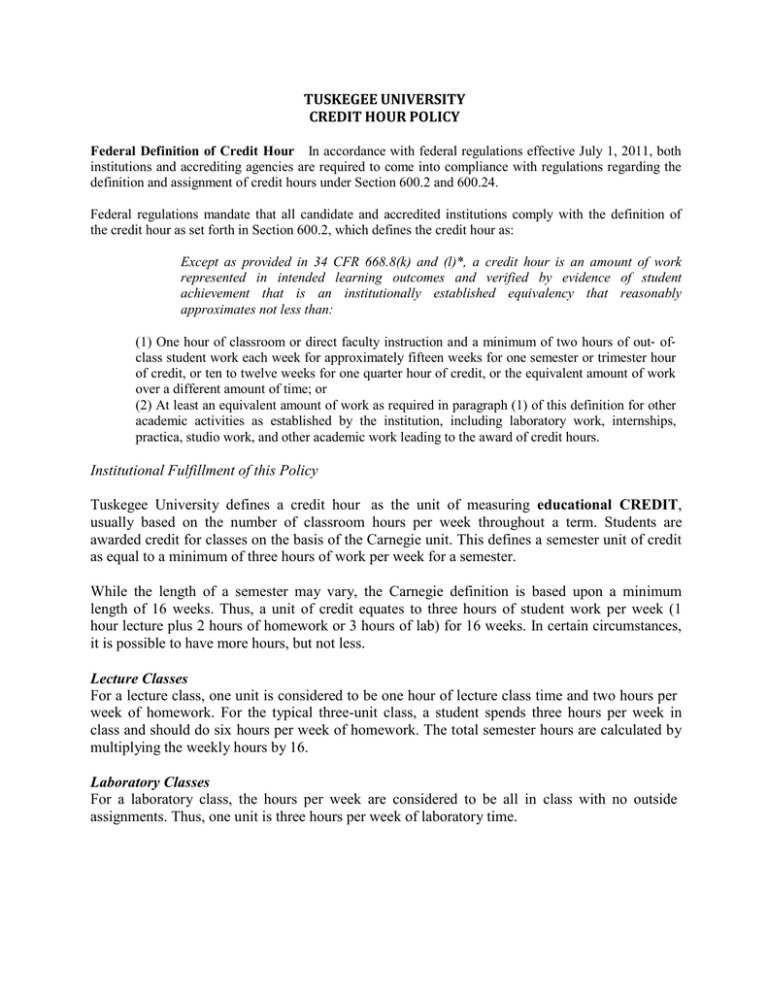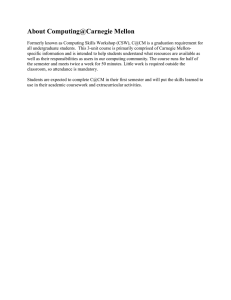TUSKEGEE UNIVERSITY CREDIT HOUR POLICY Institutional
advertisement

TUSKEGEE UNIVERSITY CREDIT HOUR POLICY Federal Definition of Credit Hour In accordance with federal regulations effective July 1, 2011, both institutions and accrediting agencies are required to come into compliance with regulations regarding the definition and assignment of credit hours under Section 600.2 and 600.24. Federal regulations mandate that all candidate and accredited institutions comply with the definition of the credit hour as set forth in Section 600.2, which defines the credit hour as: Except as provided in 34 CFR 668.8(k) and (l)*, a credit hour is an amount of work represented in intended learning outcomes and verified by evidence of student achievement that is an institutionally established equivalency that reasonably approximates not less than: (1) One hour of classroom or direct faculty instruction and a minimum of two hours of out‐ of‐ class student work each week for approximately fifteen weeks for one semester or trimester hour of credit, or ten to twelve weeks for one quarter hour of credit, or the equivalent amount of work over a different amount of time; or (2) At least an equivalent amount of work as required in paragraph (1) of this definition for other academic activities as established by the institution, including laboratory work, internships, practica, studio work, and other academic work leading to the award of credit hours. Institutional Fulfillment of this Policy Tuskegee University defines a credit hour as the unit of measuring educational CREDIT, usually based on the number of classroom hours per week throughout a term. Students are awarded credit for classes on the basis of the Carnegie unit. This defines a semester unit of credit as equal to a minimum of three hours of work per week for a semester. While the length of a semester may vary, the Carnegie definition is based upon a minimum length of 16 weeks. Thus, a unit of credit equates to three hours of student work per week (1 hour lecture plus 2 hours of homework or 3 hours of lab) for 16 weeks. In certain circumstances, it is possible to have more hours, but not less. Lecture Classes For a lecture class, one unit is considered to be one hour of lecture class time and two hours per week of homework. For the typical three-unit class, a student spends three hours per week in class and should do six hours per week of homework. The total semester hours are calculated by multiplying the weekly hours by 16. Laboratory Classes For a laboratory class, the hours per week are considered to be all in class with no outside assignments. Thus, one unit is three hours per week of laboratory time. Examples: Course Type Unit Value Lecture Hours per Lecture Hours per Homework Hours per Homework Hours per Week Semester Week Semester Lecture ONLY Courses: Homework Required Lecture 1 units 1 16 2 32 Lecture 2 units 2 32 4 64 Lecture Lecture 3 units 4 units 3 4 48 64 6 8 96 128 1 unit 3 48 Laboratory ONLY courses: No Homework or Other Outside Work Lab Update The Carnegie Unit. Retrieved from http://smccd.edu/accounts/csmcoi/forms/carnegie.pdf on March 9, 2015



